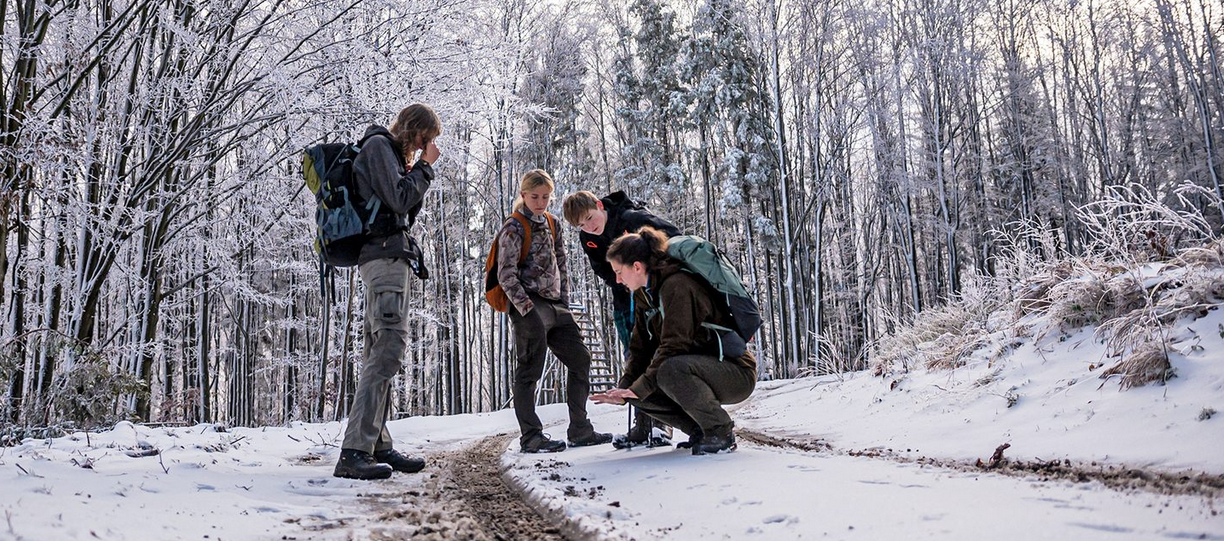“Sitting at home, I wonder what to do this weekend. I could enjoy the peace and comfort of my home — lie on the couch, watch TV, read in the garden.
Or… I could trade that comfort for a bit of adventure and go discover something new. And maybe, with just a small step, contribute to something much bigger.” That’s a thought that might also cross the minds of people joining our volunteer program “Wolf and Lynx Patrols.” It’s been running for over 20 years — we started in the Beskydy Mountains, and as large carnivores began returning, the program expanded to other corners of the Czech Republic. From a small group of enthusiasts, it has grown into a strong community of people who willingly and passionately work to protect wolves, lynx, and bears.
Support and adventures in the field
Our goal is to make volunteering as easy as possible. We began with a simple paper notebook; today, participants have access to weekend training sessions, educational materials, and our mobile app CarniTrack, which allows them to record signs of carnivores directly in the field. Never heard of it? No problem — we’re preparing another article where we’ll introduce it in detail so you can try it out in nature yourself. 😉
But volunteering isn’t just about collecting data — it’s about experiences. People see nature in its raw forms, share knowledge, meet new people, and sometimes even discover more about themselves. Every year we host 5–6 weekend training sessions, open to all ages — from 11-year-old school kids to seniors over 60. We train about 140 volunteers annually, and around 200 people take part in field patrols throughout the year — foresters, farmers, students, artists, journalists, and nature lovers of all kinds. They head into the forest along marked routes and share experiences they might never have had otherwise.
What do volunteers bring back?
Above all, data — valuable information on the presence of large carnivores in monitored areas. We regularly update and analyse this data together with experts from Mendel University. The result is an up-to-date distribution map of carnivores, used not only by scientists but also, for example, by farmers. This helps them take preventive measures in time, supported by our regional coordinators. Our colleagues then guide them through the entire project preparation process for grant applications, so they have everything needed to put the measures in place successfully.
Turning data into action
Volunteer data is also used by regional nature conservation agencies — for example, in environmental impact assessments (EIA/SEA), when granting legal exemptions, or when updating wildlife migration corridors.
And it doesn’t stop there. The collected data feeds into national-level planning — updating and reviewing species management plans for wolves, lynx, and, in the future, bears. Volunteers also contribute to the wolf management plan, which sets measures for improving coexistence with these animals, and helped develop procedures for dealing with problematic individuals.
Thanks to intensive monitoring and the large amount of SCALP-methodology data, we can provide informed feedback on legislative changes to ensure they reflect real scientific knowledge. Cross-border data sharing helps us work towards coordinated protection beyond national boundaries — because carnivores don’t recognise borders. Many wolf packs in the Czech Republic roam into Slovakia, Poland, Austria, or Germany, moving our data from national to international relevance.
From the forest to science and European policy
The data is also used in science — in analyses, research papers, and conference presentations. We’ve shared our findings in Romania and at the Alpine–Carpathian Convention in Slovenia. Volunteer monitoring even reaches into European policy — the data is shared with the Czech Nature Conservation Agency (AOPK) and can be included in reports under Article 17 of the EU Habitats Directive.
Beyond politics and science, these activities help change public attitudes, build trust in science, and strengthen people’s connection to nature.
Come experience it for yourself
This is just a glimpse of all the ways the data is used. To tell the whole story, we’d need far more space — and we don’t want to tire you out with endless reading. If you’d like to know more, join one of our training sessions and talk to us in person. Experience what our volunteers experience, and try out the CarniTrack app in the field. Just a heads-up — no two volunteer events are the same, and each one brings something new. That’s part of the magic.
You can find the original text here: https://www.selmy.cz/clanky/z-pohodli-domova-do-prirody-jak-dobrovolnici-chrani-velke-selmy/
